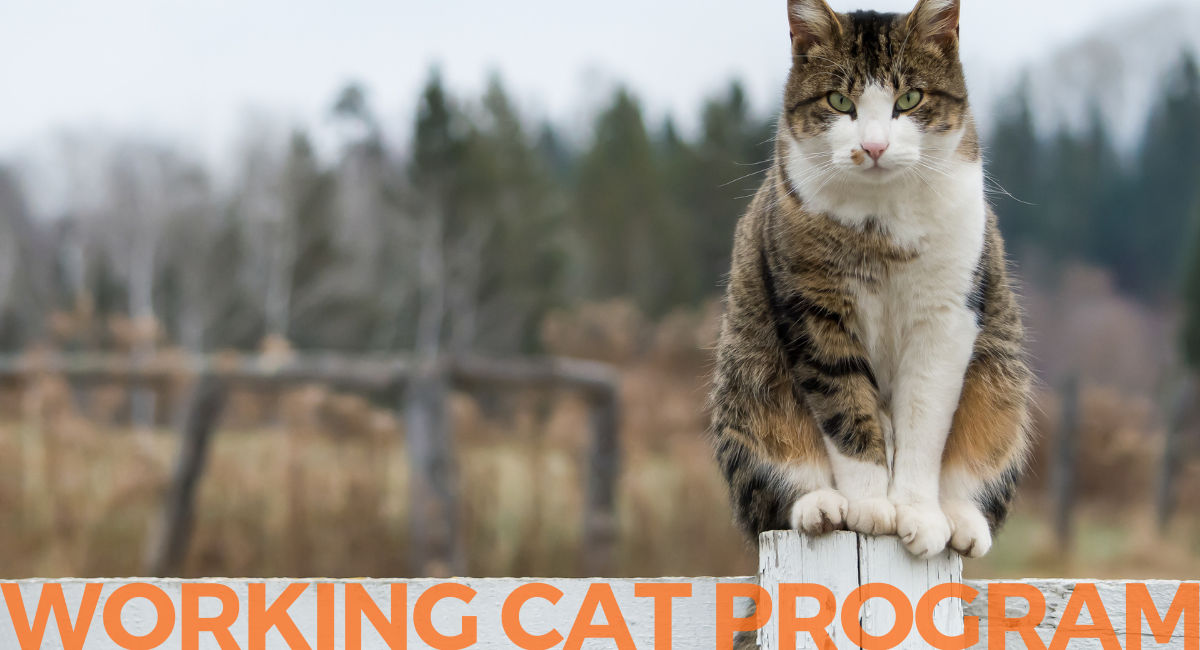Adopt A Working Cat
Are you looking for a cat to keep the rodents at bay on your property? Or maybe you have lots of land with a comfy place to sleep for a special cat in your life? Consider applying for our Working Cat Program and adopting one of our working cats.
For this program, we keep a running waitlist of adopters who are seeking vetted working cats for their barn, warehouse, or other secure alternate housing type. We typically respond within two weeks with anticipated working cat placement.
Please note: this program is separate from our regular adoption program and the cats on our adopt page are not considered for this program.
Questions?
Contact Zoe Myers, Adoption Manager: zmyers@columbushumane.org or 614-777-7387 ex. 215.
Ready to Adopt a Working Cat?
If you are ready for a working cat, please fill out the form below to be added to our waitlist. A member of our adoption team will reach out to learn more about you and discuss placement options. The adoption fee for a working cat is $50.
Working Cat FAQs
What is a working cat?
Working cats are cats who have an important job to do on a property: keeping rodents away. You may have also heard of them called “barn cats”, but cats can work in more places than a barn.
Why has Columbus Humane elected to open a Working Cat Program?
We believe that every cat deserves a chance at a home with love, food, and shelter where they can be free of stress and be their best cat self. For some cats, that home looks like a job in a barn or as an important member of staff in a library or warehouse. Some cats simply do best with the blend of freedom and security a working cat placement can provide.
Where are these working cats being placed?
We place our working cats into barns, wineries, breweries, stables, farms, and more. Any place that can (1) have a working cat and (2) keep the working cat cared for and secure is considered for the program.
What cats are being placed in this program?
These are cats (6 months and older) that are already in our care, do not have an outdoor place to return to, and will not thrive in a traditional indoor home setting through our regular adoptions. They range from social cats who enjoy the outdoors and the energy outlets it can provide to independent cats who like to have some extra room away from people. Each cat has been outside prior to our care and has a high chance of doing well outside again. They are evaluated by our behavior and medical teams to ensure their success in an indoor/outdoor or outdoor only home.
How do I apply?
Please click the link above or below to add yourself to our waitlist by emailing our Adoption Department. An adoption counselor will reach out to you for a conversation and see if the program is a fit for your property.
How much is it to adopt a working cat?
There is an adoption fee of $50, but we welcome donations added on to keep our program running.
What comes with the working cat fee?
Each cat comes spayed/neutered, microchipped, up to date on vaccines, tested for FIV and FeLV, dewormed, and up to date on flea prevention. We also ear tip the cats that we perform the spay/neuter of so that community members can see that they are altered.
Can I come to Columbus Humane to pick out a cat?
As these cats can become highly stimulated or stressed, they are kept in a quieter space off our general adoption floor. So, no, they are not able to be looked through. However, when you apply to become a placement for a working cat, you are able to tell us some traits you are looking for and we can try to make a match. We are not able to guarantee any specific cats but can try to meet some of the qualities.
Can I take home multiple working cats?
Yes! Columbus Humane occasionally gets pairs of cats looking for a working cat placement. We can also send home cats who are unfamiliar. However, we recommend having a separate space for acclimation per cat OR taking home unfamiliar cats one at a time to help them adjust then introducing the next cat in.
What do I do when I bring a working cat home?
Working cats will need time and a space dedicated to them to help them acclimate to their new environment. This process can be anywhere from two to four weeks depending on the cat. It can be done in a storage room, tack room, or large dog crate. Please see our working cat acclimation guide for more information below.
What does veterinary care look like for working cats?
Working cats are recommended to see your primary care veterinarian each year for a wellness checkup, preventative care, and any vaccines if possible. If a vet visit will cause undue stress to your working cat, we recommend that you monitor your cat for an injury or emergency needs. Please see our working cat acclimation guide for more information here below.
Do you take in feral or community cats to place in this program?
Due to our capacity and to best serve the cats in our community, we are not taking in cats for this program during this time. Cats, especially feral cats, do best staying where they are at and in an environment that they know best to limit stress to the animal as much as possible. Please see our page on Trap Neuter Return resources and information here: Community Cat Initiative.
Acclimating A Working Cat
Working cats, also referred to as barn cats, can make a great addition to a property in need of rodent control. An acclimation process is vital in helping the new cat recognize the property as home and not get lost in an unfamiliar area.
Creating a Home Base
The first step is setting up an enclosed area within the building they will call “home” to acclimate in. This area can be an extra-large dog crate, tack room, storeroom, or other secure space. Check this area for any possible escape routes, place fans for warm weather or heaters for cold weather and set it up with supplies for the cat prior to letting them loose in the enclosure.
There should be enough room in the home base for the following items:
Bowls for food and water
A litter box with litter
A cat hut to hide in (a cardboard box can work for this)
Blankets and comfort items
Some toys and entertainment
Getting Your New Cat Home
This will be a big change for your kitty! It is important to try to reduce stress wherever possible. Bring the carrier directly to the home base and let them have time to decompress. The carrier can be set in the space and opened so the cat can decide when they are ready to come out.
You’ll want to have your cat remain in the home base for at least two to four weeks and get them on a schedule for feedings. Working cats still need a stable diet of dry food to encourage them to stay - mice alone are not enough. In addition to dry food, wet food is an especially great motivator to build a bond with your cat. Pick a time in the morning and at night to feed. This gets them on a schedule to come check in, which is helpful for once they are free roaming.
Transitioning to Free Roam
After a few weeks in the home base, it is time to start letting your working cat explore. You can open the door to their enclosure to let them out and monitor them during the day. They have likely become comfortable in their space, so it may take some time for them to want to explore. Continue feeding your cat in the home base at the same time and provide fresh water daily.
Continued Medical Care
Working cats are recommended to see your primary care veterinarian each year for a wellness checkup, preventative care, and any vaccines if possible. If a vet visit will cause undue stress to your working cat, we recommend that you monitor your cat for an injury or emergency needs. The cat should see a vet if injured or very ill. If your property has a veterinarian visit for livestock, check if they do wellness exams on working cats. Otherwise, they can go into a clinic.








